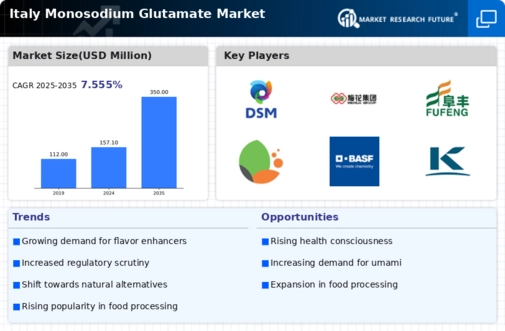The competitive dynamics of the monosodium glutamate market in Italy reflect a landscape characterized by both innovation and strategic maneuvering among key players. The market appears to be driven by increasing consumer demand for flavor enhancers in the food industry, alongside a growing awareness of health and wellness. Major companies such as Ajinomoto (Japan), Fufeng Group (China), and Meihua Group (China) are actively shaping this environment through various strategies. Ajinomoto (Japan) focuses on innovation in product development, particularly in creating MSG variants that cater to health-conscious consumers. Meanwhile, Fufeng Group (China) emphasizes regional expansion, aiming to enhance its market presence in Europe, while Meihua Group (China) is investing in digital transformation to streamline operations and improve customer engagement. Collectively, these strategies contribute to a competitive landscape that is both moderately fragmented and dynamic.
Key business tactics employed by these companies include localizing manufacturing and optimizing supply chains to enhance efficiency and reduce costs. The market structure is moderately fragmented, with several players vying for market share, yet the influence of major companies remains substantial. This competitive environment encourages innovation and responsiveness to consumer preferences, which are critical for maintaining market relevance.
In November 2025, Ajinomoto (Japan) announced the launch of a new line of reduced-sodium monosodium glutamate products aimed at health-conscious consumers. This strategic move is significant as it aligns with the growing trend towards healthier eating habits, potentially capturing a larger segment of the market that is increasingly wary of sodium intake. By positioning itself as a leader in health-oriented products, Ajinomoto (Japan) reinforces its competitive edge.
In October 2025, Fufeng Group (China) revealed plans to establish a new production facility in Italy, which is expected to enhance its supply chain capabilities and reduce lead times for European customers. This expansion is indicative of Fufeng's commitment to strengthening its foothold in the European market, allowing for greater responsiveness to local demand and potentially increasing its market share in the region.
In September 2025, Meihua Group (China) launched an advanced digital platform designed to facilitate direct engagement with customers and streamline order processing. This initiative is crucial as it reflects the company's focus on digital transformation, which is becoming increasingly important in enhancing customer experience and operational efficiency. By leveraging technology, Meihua Group (China) positions itself to better meet the evolving needs of its clientele.
As of December 2025, current trends in the monosodium glutamate market indicate a shift towards digitalization, sustainability, and the integration of AI technologies. Strategic alliances among companies are becoming more prevalent, fostering collaboration that enhances innovation and market reach. Looking ahead, competitive differentiation is likely to evolve, with a pronounced shift from price-based competition to a focus on innovation, technology, and supply chain reliability. This transition suggests that companies will need to invest in research and development to stay ahead in a rapidly changing market.

















Leave a Comment